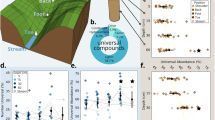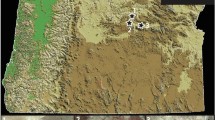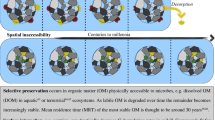Abstract
In the mostly pristine Congo Basin, agricultural land-use change has intensified in recent years. One potential and understudied consequence of this deforestation and conversion to agriculture is the mobilization and loss of organic matter from soils to rivers as dissolved organic matter. Here, we quantify and characterize dissolved organic matter sampled from 19 catchments of varying deforestation extent near Lake Kivu over a two-week period during the wet season. Dissolved organic carbon from deforested, agriculturally dominated catchments was older (14C age: ~1.5 kyr) and more biolabile than from pristine forest catchments. Ultrahigh-resolution mass spectrometry revealed that this aged organic matter from deforested catchments was energy rich and chemodiverse, with higher proportions of nitrogen- and sulfur-containing formulae. Given the molecular composition and biolability, we suggest that organic matter from deforested landscapes is preferentially respired upon disturbance, resulting in elevated in-stream concentrations of carbon dioxide. We estimate that while deforestation reduces the overall flux of dissolved organic carbon by approximately 56%, it does not significantly change the yield of biolabile dissolved organic carbon. Ultimately, the exposure of deeper soil horizons through deforestation and agricultural expansion releases old, previously stable, and biolabile soil organic carbon into the modern carbon cycle via the aquatic pathway.
This is a preview of subscription content, access via your institution
Access options
Access Nature and 54 other Nature Portfolio journals
Get Nature+, our best-value online-access subscription
$29.99 / 30 days
cancel any time
Subscribe to this journal
Receive 12 print issues and online access
$259.00 per year
only $21.58 per issue
Buy this article
- Purchase on Springer Link
- Instant access to full article PDF
Prices may be subject to local taxes which are calculated during checkout



Similar content being viewed by others
Data availability
The authors declare that all data supporting the findings of this study other than non-categorized FT-ICR MS data are available within the paper and its supplementary information files. Non-categorized FT-ICR MS formulae data are available from the corresponding author upon request.
References
Köchy, M., Hiederer, R. & Freibauer, A. Global distribution of soil organic carbon—Part 1: masses and frequency distributions of SOC stocks for the tropics, permafrost regions, wetlands, and the world. Soil 1, 351–365 (2015).
Don, A., Schumacher, J. & Freibauer, A. Impact of tropical land-use change on soil organic carbon stocks—a meta-analysis. Glob. Change Biol. 17, 1658–1670 (2011).
Schlesinger, W. H. & Andrews, J. A. Soil respiration and the global carbon cycle. Biogeochemistry 48, 7–20 (2000).
Houghton, R. A. The annual net flux of carbon to the atmosphere from changes in land use 1850–1990. Tellus B Chem. Phys. Meteorol. 51, 298–313 (1999).
Guo, L. B. & Gifford, R. M. Soil carbon stocks and land use change: a meta analysis. Glob. Change Biol. 8, 345–360 (2002).
Stanley, E. H., Powers, S. M., Lottig, N. R., Buffam, I. & Crawford, J. T. Contemporary changes in dissolved organic carbon (DOC) in human-dominated rivers: is there a role for DOC management? Freshw. Biol. 57, 26–42 (2012).
Schelker, J., Grabs, T., Bishop, K. & Laudon, H. Drivers of increased organic carbon concentrations in stream water following forest disturbance: separating effects of changes in flow pathways and soil warming. J. Geophys. Res. Biogeosci. 118, 1814–1827 (2013).
Chow, A. T., Dahlgren, R. A. & Harrison, J. A. Watershed sources of disinfection byproduct precursors in the Sacramento and San Joaquin rivers, California. Environ. Sci. Technol. 41, 7645–7652 (2007).
Chen, X. & Driscoll, C. T. Watershed land use controls on chemical inputs to Lake Ontario embayments. J. Environ. Qual. 38, 2084–2095 (2009).
Meyer, J. L. & Tate, C. M. The effects of watershed disturbance on dissolved organic carbon dynamics of a stream. Ecology 64, 33–44 (1983).
Cronan, C. S., Piampiano, J. T. & Patterson, H. H. Influence of land use and hydrology on exports of carbon and nitrogen in a Maine river basin. J. Environ. Qual. 28, 953–961 (1999).
Moore, S. et al. Deep instability of deforested tropical peatlands revealed by fluvial organic carbon fluxes. Nature 493, 660–663 (2013).
Rixen, T., Baum, A., Wit, F. & Samiaji, J. Carbon leaching from tropical peat soils and consequences for carbon balances. Front. Earth Sci. 4, 563 (2016).
Butman, D. E., Wilson, H. F., Barnes, R. T., Xenopoulos, M. A. & Raymond, P. A. Increased mobilization of aged carbon to rivers by human disturbance. Nat. Geosci. 8, 112–116 (2014).
Lu, Y. H. et al. Effects of land use on sources and ages of inorganic and organic carbon in temperate headwater streams. Biogeochemistry 119, 275–292 (2014).
Raymond, P. A. & Bauer, J. E. Riverine export of aged terrestrial organic matter to the North Atlantic Ocean. Nature 409, 497–500 (2001).
Mayorga, E. et al. Young organic matter as a source of carbon dioxide outgassing from Amazonian rivers. Nature 436, 538–541 (2005).
Barnes, R. T., Butman, D. E., Wilson, H. F. & Raymond, P. A. Riverine export of aged carbon driven by flow path depth and residence time. Environ. Sci. Technol. 52, 1028–1035 (2018).
Mann, P. J. et al. Utilization of ancient permafrost carbon in headwaters of Arctic fluvial networks. Nat. Commun. 6, 7856 (2015).
Hood, E. et al. Glaciers as a source of ancient and labile organic matter to the marine environment. Nature 462, 1044–1047 (2009).
Nachtergaele, F. et al. Harmonized World Soil Database Version 1.1 (ISRIC, 2009, accessed June 2018).
Dargie, G. C. et al. Age, extent and carbon storage of the central Congo Basin peatland complex. Nature 542, 86–90 (2017).
Ickowitz, A., Slayback, D., Asanzi, P. & Nasi, R. Agriculture and Deforestation in the Democratic Republic of the Congo: A Synthesis of the Current State of Knowledge (CIFOR, 2015).
Hansen, M. C. et al. High-resolution global maps of 21st-century forest cover change. Science 342, 850–853 (2013).
Potapov, P. V. et al. Quantifying forest cover loss in Democratic Republic of the Congo, 2000–2010, with Landsat ETM + data. Remote Sens. Environ. 122, 106–116 (2012).
Kabonyi, C., Roche, E. & Gerrienne, P. Paléoenvironnements et paléoclimats durant le Pléistocène supérieur et l’Holocène sur la dorsale occidentale du Kivu en République Démocratique du Congo. Eur. Sci. J. 11, 38–63 (2015).
Boström, B., Comstedt, D. & Ekblad, A. Isotope fractionation and 13C enrichment in soil profiles during the decomposition of soil organic matter. Oecologia 153, 89–98 (2007).
Rumpel, C. & Kögel-Knabner, I. Deep soil organic matter—a key but poorly understood component of terrestrial C cycle. Plant Soil 338, 143–158 (2011).
Koch, B. P. & Dittmar, T. From mass to structure: an aromaticity index for high-resolution mass data of natural organic matter. Rapid Commun. Mass Spectrom. 20, 926–932 (2006).
Wagner, S. et al. Linking the molecular signature of heteroatomic dissolved organic matter to watershed characteristics in world rivers. Environ. Sci. Technol. 49, 13798–13806 (2015).
Riedel, T. et al. Molecular signatures of biogeochemical transformations in dissolved organic matter from ten world rivers. Front. Earth Sci. 4, G01004 (2016).
D’Andrilli, J., Cooper, W. T., Foreman, C. M. & Marshall, A. G. An ultrahigh-resolution mass spectrometry index to estimate natural organic matter lability. Rapid Commun. Mass Spectrom. 29, 2385–2401 (2015).
Stubbins, A. et al. Illuminated darkness: molecular signatures of Congo River dissolved organic matter and its photochemical alteration as revealed by ultrahigh precision mass spectrometry. Limnol. Oceanogr. 55, 1467–1477 (2010).
Spencer, R. G. M. et al. Utilizing chromophoric dissolved organic matter measurements to derive export and reactivity of dissolved organic carbon exported to the Arctic Ocean: a case study of the Yukon River, Alaska. Geophys. Res. Lett. 36, L06401 (2009).
Kellerman, A. M. et al. Unifying concepts linking dissolved organic matter composition to persistence in aquatic ecosystems. Environ. Sci. Technol. 52, 2538–2548 (2018).
Kaiser, K. & Kalbitz, K. Cycling downwards-dissolved organic matter in soils. Soil Biol. Biochem. 52, 29–32 (2012).
Kögel-Knabner, I., Totsche, K. U. & Raber, B. Desorption of polycyclic aromatic hydrocarbons from soil in the presence of dissolved organic matter: effect of solution composition and aging. J. Environ. Qual. 29, 906–916 (2000).
Wilson, H. F. & Xenopoulos, M. A. Effects of agricultural land use on the composition of fluvial dissolved organic matter. Nat. Geosci. 2, 37–41 (2008).
Creed, I. F. et al. Global change-driven effects on dissolved organic matter composition: implications for food webs of northern lakes. Glob. Change Biol. 24, 3692–3714 (2018).
Berggren, M., Laudon, H., Haei, M., Ström, L. & Jansson, M. Efficient aquatic bacterial metabolism of dissolved low-molecular-weight compounds from terrestrial sources. ISME J. 4, 408–416 (2010).
van Hees, P. A. W., Jones, D. L., Finlay, R., Godbold, D. L. & Lundström, U. S. The carbon we do not see—the impact of low molecular weight compounds on carbon dynamics and respiration in forest soils: a review. Soil Biol. Biochem. 37, 1–13 (2005).
Kalbitz, K. et al. Changes in properties of soil-derived dissolved organic matter induced by biodegradation. Soil Biol. Biochem. 35, 1129–1142 (2003).
Spencer, R. G. M. et al. Detecting the signature of permafrost thaw in Arctic rivers. Geophys. Res. Lett. 42, 2830–2835 (2015).
Singer, G. A. et al. Biogeochemically diverse organic matter in Alpine glaciers and its downstream fate. Nat. Geosci. 5, 710–714 (2012).
Spencer, R. G. M. et al. Source and biolability of ancient dissolved organic matter in glacier and lake ecosystems on the Tibetan Plateau. Geochim. Cosmochim. Acta 142, 64–74 (2014).
Schmidt, M. W. I. et al. Persistence of soil organic matter as an ecosystem property. Nature 478, 49–56 (2011).
Kögel-Knabner, I. The macromolecular organic composition of plant and microbial residues as inputs to soil organic matter. Soil Biol. Biochem. 34, 139–162 (2002).
Denef, K., Planet, A. F. & Six, J. in Soil Carbon Dynamics: An Integrated Methodology (eds Kutsch, W. L. et al.) 91–126 (Cambridge Univ. Press, 2009).
Demars, B. O. L. et al. Temperature and the metabolic balance of streams. Freshw. Biol. 56, 1106–1121 (2011).
Macedo, M. N. et al. Land-use-driven stream warming in southeastern Amazonia. Phil. Trans. R. Soc. Lond. B 368, 20120153 (2013).
Baccini, A., Laporte, N., Goetz, S. J., Sun, M. & Dong, H. A first map of tropical Africa’s above-ground biomass derived from satellite imagery. Environ. Res. Lett. 3, 045011 (2008).
Spencer, R. G. M. et al. An initial investigation into the organic matter biogeochemistry of the Congo River. Geochim. Cosmochim. Acta 84, 614–627 (2012).
Gerland, P. et al. World population stabilization unlikely this century. Science 346, 234–237 (2014).
World Population Prospects 2017 (United Nations, 2017); https://esa.un.org/unpd/wpp/
Govers, G., Merckx, R., Van Oost, K. & van Wesemael, B. Managing Soil Organic Carbon for Global Benefits: A Stap Technical Report (Global Environmental Facility, 2013).
Tarboton, D. TauDEM Version 5 (accessed 15 February 2018); http://hydrology.usu.edu/taudem/taudem5/
NASA Shuttle Radar Topography Mission Global 1 Arc Second (NASA LP DAAC, 2013).
Friedl, M. A. et al. MODIS Collection 5 global land cover: algorithm refinements and characterization of new datasets. Remote Sens. Environ. 114, 168–182 (2010).
Drake, T. W. et al. The ephemeral signature of permafrost carbon in an arctic fluvial network. J. Geophys. Res. Biogeosci. 123, 1475–1485 (2018).
Werner, R. A., Bruch, B. A. & Brand, W. A. ConFlo III-an interface for high precision δ13C and δ15N analysis with an extended dynamic range. Rapid Commun. Mass Spectrom. 13, 1237–1241 (1999).
Brooks, P. D., Geilmann, H., Werner, R. A. & Brand, W. A. Improved precision of coupled δ13C and δ15N measurements from single samples using an elemental analyzer/isotope ratio mass spectrometer combination with a post-column six-port valve and selective CO2 trapping; improved halide robustness of the combustion reactor using CeO2. Rapid Commun. Mass Spectrom. 17, 1924–1926 (2003).
Steinhof, A., Altenburg, M. & Machts, H. Sample preparation at the Jena 14C Laboratory. Radiocarbon 59, 815–830 (2017).
Turnbull, J. C. et al. Sixty years of radiocarbon dioxide measurements at Wellington, New Zealand: 1954–2014. Atmos. Chem. Phys. 17, 14771–14784 (2017).
Stuiver, M. & Polach, H. A. Discussion: reporting of 14C data. Radiocarbon 19, 355–363 (1977).
Smith, D. F., Podgorski, D. C., Rodgers, R. P., Blakney, G. T. & Hendrickson, C. L. 21 Tesla FT-ICR mass spectrometer for ultrahigh-resolution analysis of complex organic mixtures. Anal. Chem. 90, 2041–2047 (2018).
Hendrickson, C. L. et al. 21 Tesla Fourier transform ion cyclotron resonance mass spectrometer: a national resource for ultrahigh resolution mass analysis. J. Am. Soc. Mass Spectrom. 26, 1626–1632 (2015).
Seabold, S. & Perktold, J. Statsmodels: econometric and statistical modeling with python. In Proc. 9th Python in Science Conference 57–61 (SciPy Society, 2010).
Hemingway, J. D. fouriertransform: open-source tools for FT-ICR MS data analysis. GitHub https://github.com/FluvialSeds/fouriertransform (2017).
Acknowledgements
We thank our network of collaborators at the International Institute of Tropical Agriculture and the Université Catholique de Bukavu in DR Congo for their local expertise and logistical assistance. Funding for this research was provided by the Winchester Fund at Florida State University. This work was partially supported by National Science Foundation grants OCE 1464396 to R.G.M.S., and DMR-1157490 and DMR-1644779 to the National High Magnetic Field Laboratory. K.V.O. received funding from FNRS. A.M.H. and S.E.T. received funding from the European Research Council under the European Union’s Horizon 2020 research and innovation programme (grant agreement no. 695101 (14 Constraint)).
Author information
Authors and Affiliations
Contributions
T.W.D., R.G.M.S., J.S., and K.V.O. conceived the study. T.W.D., M.Barthel and M.Bauters carried out the fieldwork and sample collection. T.W.D., M.Barthel, M.Bauters, A.M.H. and D.C.P. performed sample analyses. T.W.D., K.V.O. and M.Bauters performed geospatial analyses. L.C.N. provided logistical support in DR Congo. T.W.D. wrote the manuscript with significant contributions from M.Bauters, A.M.H., J.S., P.B., S.E.T. and R.G.M.S.
Corresponding author
Ethics declarations
Competing interests
The authors declare no competing interests.
Additional information
Publisher’s note: Springer Nature remains neutral with regard to jurisdictional claims in published maps and institutional affiliations.
Supplementary information
Supplementary Information
Supplementary description, Supplementary Figs. 1–6 and Supplementary Tables 1–3.
Rights and permissions
About this article
Cite this article
Drake, T.W., Van Oost, K., Barthel, M. et al. Mobilization of aged and biolabile soil carbon by tropical deforestation. Nat. Geosci. 12, 541–546 (2019). https://doi.org/10.1038/s41561-019-0384-9
Received:
Accepted:
Published:
Issue Date:
DOI: https://doi.org/10.1038/s41561-019-0384-9
This article is cited by
-
The chemical succession in anoxic lake waters as source of molecular diversity of organic matter
Scientific Reports (2024)
-
River ecosystem metabolism and carbon biogeochemistry in a changing world
Nature (2023)
-
Determining patterns in the composition of dissolved organic matter in fresh waters according to land use and management
Biogeochemistry (2023)
-
Characterization of dissolved organic matter distribution in forestland and farmland of mollisol based on untargeted metabolomics
Soil Ecology Letters (2023)
-
Anthropogenic landcover impacts fluvial dissolved organic matter composition in the Upper Mississippi River Basin
Biogeochemistry (2023)



